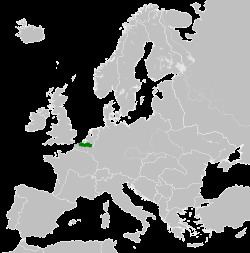1944–1945 → Capital Antwerp Established 15 December 1944 | Flag Coat of arms 1944–1945 Jef van de Wiele Today part of Belgium | |
 | ||
The Reichsgau Flanders (German: Reichsgau Flandern; Dutch: Rijksgouw Vlaanderen) was a short-lived Reichsgau of Nazi Germany established in 1944. It encompassed the present-day Flemish Region in its old provincial borders (in other words, including Comines-Warneton but excluding Voeren). Brussels was also excluded and given its own territorial arrangement.
History
After its invasion by Germany in June 1940, Belgium was initially placed under a "temporary" military government, in spite of more radical factions within the German government, such as the SS, urging for the installation of another Nazi civil government, as had been done in Norway and the Netherlands. It was joined together with the two French départements of Nord and Pas-de-Calais (included on the grounds that part of this territory belonged to Germanic Flanders, as well as the fact that the entire region formed an integral economic unit) as the Military Administration in Belgium and North France (Militärverwaltung in Belgien und Nordfrankreich).
In spite of this uncompromising attitude at the time, it was decided that the entire area should someday be assimilated into the Third Reich and divided into three new Reichsgaue of a Greater Germanic Reich: Flandern and Brabant for the Flemish territories, and Wallonien for the Walloon parts. Reichsgau Brabant was to be headed by Gauleiter U. van Brusselen. On 12 July 1944, a Reichskommissariat Belgien-Nordfrankreich was established to accomplish precisely this goal, derived from the previous military administration. This step was curiously only taken at the very end of World War II, when Germany's armies were already in full retreat. The new government was already ousted by the Allied advances in Western Europe in September 1944, and the authority of the Belgian government-in-exile was restored. The actual incorporation into the Nazi state of these new provinces therefore only occurred de jure and with its leaders already in exile in Germany. The only place where any notable gain was made in re-establishing Reich authority occurred in parts of southern Wallonia during the Ardennes Campaign. The collaborators merely achieved a Pyrrhic victory since when the Allied tanks had rolled into Belgium several months before this already signalled the end of their personal domains in the Reich. Many of their supporters fled to Germany where they were conscripted into the Waffen-SS to participate in the final military campaigns of the Third Reich.
In December 1944, Belgium (theoretically including the two French departments) was split into a Reichsgau Flandern, a Reichsgau Wallonien, and a Distrikt Brüssel, all of which were nominally annexed by the Greater German Reich (therefore excluding the proposed Brabant province). In Flanders the DeVlag party under the leadership of Jef van de Wiele became the sole political party, in Wallonia the Rexist Party under the leadership of Léon Degrelle. Van de Wiele was appointed "National Leader of the Flemish people" (Landsleider van het Vlaamsche volk) in addition to the usual titles of Gauleiter und Reichsstatthalter bestowed upon Nazi German regional administrators. He also became the "Head of the Flemish Liberation Committee" (Hoofd van het Vlaamsche Bevrijdingscomité).
